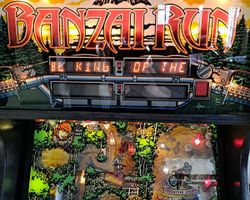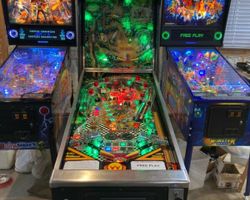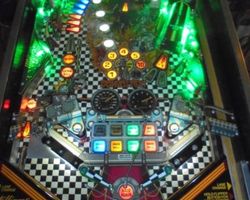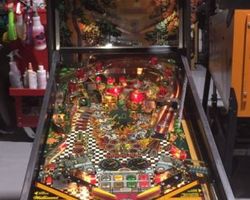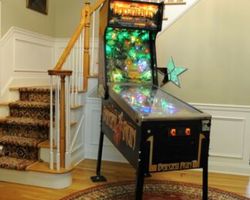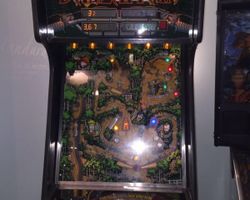Banzai Run
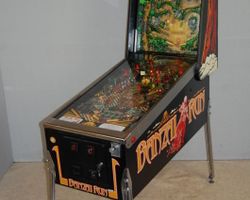
Average Prices: USD $900 to $5,500
Produced: May, 1988
Production Run: 1,750 units
Machine Type: Solid State Electronic
MPU: Williams System 11B
Players: 4
Concept by: Pat Lawlor
Design by: Pat Lawlor, Larry DeMar
Art by: Mark Sprenger
Mechanics by: John Krutsch
Music by: Brian Schmidt
Sound by: Brian Schmidt
Software by: Larry DeMar, Ed Boon
In May of 1988, Williams Electronic Games, Inc. introduced a pinball machine that defied conventional design, offering an unprecedented experience across two distinct playfields. This machine was Banzai Run, a motocross-themed title that aimed to push the boundaries of what a pinball game could be. Its creation was the result of a concerted effort by a talented team, including Pat Lawlor, who made his playfield design debut with Banzai Run. Larry DeMar contributed to the design and software, while Mark Sprenger brought the vibrant motocross world to life through his artwork. Brian Schmidt crafted the distinctive music and sound, and John Krutsch handled the mechanical engineering, with Ed Boon also contributing to the software development.
The genesis of Banzai Run was not a straightforward path to motocross. The concept initially began as a construction-themed prototype titled "Wreck'n Ball." This early iteration laid the groundwork for the two-tiered playfield idea before evolving into the high-octane racing theme. Released with a production run of 1,751 units, Banzai Run also marked a few technical firsts for Williams' System 11B generation. It was among the initial machines to utilize low-voltage switches for the flipper buttons, enabling them to trigger sounds even during attract mode, a subtle yet innovative detail. Furthermore, the software was capable of adjusting to a missing ball in the trough, preventing a game from going out of service, a feature that would become more refined in subsequent Williams titles. Collectors might also note the existence of sample models featuring a special playfield coating, which would later be known as "Diamond Plate," a testament to the continuous innovation happening at Williams during this period. The artwork on the playfield itself even paid homage to its creators, subtly incorporating the names of the design team—John Krutsch, Pat Lawlor, Ed Boon, Mark Sprenger, and Brian Schmidt—onto the jerseys of the motocross racers depicted.
Dual Dynamics: Banzai Run's Defining Features
The defining characteristic of the Banzai Run pinball machine is its unparalleled dual-plane playfield design. Unlike any other machine of its era, Banzai Run features a full, vertical playfield housed within the backbox. This extraordinary design element is not merely decorative; it is an integrated, active part of the game’s progression. A sophisticated mechanical system, featuring a magnet on a moving vertical track, is employed to lift the ball from the main horizontal playfield directly into this upper, vertical arena.
This unique two-level setup necessitates a total of six flippers—three on the conventional lower playfield and three positioned vertically on the upper backbox playfield. This configuration allows for continuous, dynamic play across both dimensions. Beyond the primary innovation, the lower playfield is equipped with a host of other elements that contribute to the gameplay, including three pop bumpers, a single ramp, a kick-out hole, two spinning targets, and a left outlane kickback mechanism designed to save a draining ball. Three captive balls, one horizontal and two vertical, provide additional target opportunities, while an up-post positioned between the bottom flippers of the vertical playfield adds another layer of challenge and control on the upper level. A ball kicker near the left slingshot on the main playfield offers strategic shots. These interconnected features work in concert to create a multifaceted and visually striking experience, setting Banzai Run apart from its contemporaries.
Navigating the Racecourse: Playfield Layout and Mechanics
The Banzai Run pinball machine presents players with a distinctly bifurcated playfield experience. The lower, horizontal playfield serves as the foundation, featuring a classic layout with a central ramp, various targets, and three strategically placed pop bumpers that energize ball movement. Key shots include the kick-out hole and the spinning targets, which contribute to point accumulation and activate game features. The left outlane kickback is a welcome save, extending ball time for players who find their ball heading for an early drain. The presence of three captive balls encourages precise aiming, rewarding players for hitting these static targets. The artwork on this lower playfield is a vibrant tableau of motocross action, with racers depicted in various stages of a challenging race, capturing the theme's intensity. Mark Sprenger's artistic contribution ensures that the visual identity aligns perfectly with the high-speed concept.
The transition to the upper playfield is where Banzai Run truly distinguishes itself. Once the ball is magnetically lifted to the backbox, players are presented with a completely different spatial challenge. This vertical playfield, while smaller, is fully functional, equipped with three dedicated flippers. The layout here is designed to test a player's ability to adapt to a new set of physics and angles. Shots on the upper playfield are critical for advancing game objectives and accumulating points on a separate, elevated plane. When the ball eventually drains from the bottom of the vertical playfield, it seamlessly returns to the lower main playfield, creating a continuous loop of action and strategic decision-making. This inter-playfield flow is the core design philosophy, immersing the player in a simulated race that progresses across different elevations, maintaining engagement and visual excitement through its distinct two-tiered setup and evocative lighting.
Mastering the Maneuvers: Banzai Run's Gameplay Dynamics
Banzai Run offers a captivating gameplay progression centered around its unique dual-playfield structure. The game begins on the main horizontal playfield, where players work to hit various targets, ramps, and spinners to build scores and activate features. The ultimate objective, and indeed the game's namesake, is to reach the "Banzai Run" itself, which translates to activating the magnetic lift that transports the ball to the vertical playfield in the backbox. This transition is a core gameplay mechanic, fundamentally altering the player's perspective and the physics of the game.
Once on the vertical playfield, players engage with a different set of challenges, using the three dedicated flippers to hit targets and score points. The goal here is to prolong the ball's stay on the upper playfield for as long as possible, accumulating high scores before it eventually drains back to the lower playfield. The game also features a two-ball multiball mode, adding another layer of excitement and scoring potential. Although the machine is typically loaded with three balls in the trough, only two are actively used for multiball, a design choice that adds a subtle layer of robustness to the game's operation. Strategic gameplay in Banzai Run involves a constant interplay between the two fields; players must master shots on the lower field to earn access to the upper, and then adapt their flipper skills to the vertical plane to maximize their time and points during the "Banzai Run." This continuous ebb and flow between the two dimensions makes each game a distinct and memorable challenge, pushing players to refine their skills across different environments.
Enduring Impressions: Reception and Legacy
Banzai Run earned a reputation for its audacious innovation upon its release. The overwhelming sentiment within the pinball community centers on its unique vertical playfield, which is consistently cited as a standout feature. This novel approach to pinball design offered a distinct experience that set the machine apart from its contemporaries, often praised for its ability to surprise and engage new players. The motocross theme, complemented by Mark Sprenger's period-appropriate artwork and Brian Schmidt's energetic music and sound design, contributed to a cohesive and immersive atmosphere that resonated particularly well with those who appreciated the aesthetics and culture of the 1980s. Many players found the ruleset intuitive and easy to grasp, making it accessible while still offering depth for sustained engagement.
Despite its many strengths, Banzai Run also faced specific criticisms. The very innovation that defined it—the dual playfields—presented maintenance challenges due to its complexity. Some players noted that the gameplay, particularly on the vertical playfield, could become somewhat repetitive over extended sessions, and the unique physics of the upper section were not universally enjoyed. Additionally, the age and relative rarity of the machine mean that finding replacement parts can be difficult for collectors and operators.
However, these points rarely overshadow the machine's overall positive standing. Banzai Run holds a special place in pinball history, not just for its bold mechanical design but also as Pat Lawlor's first playfield design. This debut set the stage for a career that would produce some of the most enduring and commercially successful pinball machines. Banzai Run’s significance lies in its willingness to experiment, to break from established norms, and to deliver an experience that, while perhaps not perfect, was undeniably daring and memorable. Its influence is evident in the ongoing discussion about how designers can push the boundaries of pinball, serving as a testament to creative engineering and imaginative playfield concepts.
Sponsored Links
 Ebay Listings
Ebay Listings
 Auction Results
Auction Results
| Cost | Location | Date |
|---|---|---|
| USD $19,000 |  Georgia, United States Georgia, United States |
14 April, 2025 |
| USD $13,500 |  Connecticut, United States Connecticut, United States |
15 December, 2024 |
| USD $10,250 |  Georgia, United States Georgia, United States |
09 June, 2024 |
| GBP £5,123 |  Haverhill, United Kingdom Haverhill, United Kingdom |
21 March, 2022 |
| USD $6,900 |  Louisiana, United States Louisiana, United States |
03 January, 2022 |
| USD $7,649 |  Minnesota, United States Minnesota, United States |
09 May, 2021 |
| USD $6,900 |  Florida, United States Florida, United States |
06 October, 2020 |
| USD $12,000 |  Florida, United States Florida, United States |
29 August, 2019 |
| USD $5,000 |  Kansas, United States Kansas, United States |
06 April, 2019 |
| USD $7,100 |  Ohio, United States Ohio, United States |
10 March, 2019 |


Private Policy · Search Website · Contact Us
As an eBay Partner, we may earn a commission from qualifying purchases made through links on this site, at no additional cost to you.
All trademarks and copyrighted materials remain property of their respective owners. All other content copyright 2007 - 2026 Pinpedia.

